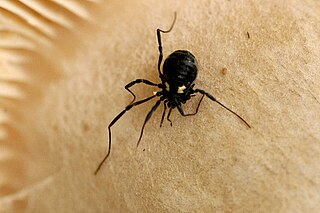
Dyspnoi is a suborder of harvestmen, currently comprising 43 extant genera and 356 extant species, although more species are expected to be described in the future. The eight families are currently grouped into three superfamilies: the Acropsopilionoidea, Ischyropsalidioidea, and Troguloidea.

Nipponopsalididae is a family of harvestmen with three described species in one genus, Nipponopsalis, which is found in East Asia.

The Nemastomatidae are a family of harvestmen with about 170 described species in 16 recent genera. Several fossil species and genera are known.

The Dicranolasmatidae are a monotypic family of harvestmen with 16 described species in a single genus, Dicranolasma.
Carinostoma is a genus of harvestmen in the family Nemastomatidae with 3 described species from southeastern Europe.
Crosbycus is a potentially monotypic genus of harvestmen in the family Taracidae, with one species found in North America as of 2023, per the World Catalog of Opiliones.
Cladolasma, is a genus of harvestmen belonging to the family Nemastomatidae. The genus is monotypic containing 1 species Cladolasma parvulum Suzuki, 1963. They are endemic to Japan, with records in Ehime and Tokushima Prefectures. The genus was described by Seisho Suzuki, with the type species Cladolasma parvulum Suzuki, 1963, subsequently revised to Dendrolasma parvulum in Suzuki (1974), but later restored as a valid genus.
Asiolasma angka, is a species of harvestmen belonging to the family Nemastomatidae. It is found in Chiang Mai, Thailand. It was initially described in the genus Dendrolasma before being transferred in genus Cladolasma, then later redefined within Asiolasma when that genus was newly described.

Ortholasma is a genus of harvestmen in the family Nemastomatidae with 5 described species. The genus has been revised by Shear (2010).

Dendrolasma mirabile is a species of harvestman in the family Nemastomatidae. It is found in North America, in the Pacific Northwest of the USA and Canada. The species was described by Nathan Banks, who reported the original specimen from USA, "Washington State", consistent with later records over a wider geographic range.

Dendrolasma is a genus of harvestmen in the family Nemastomatidae with two described species. Both species are found in the western coast of North America. An overview of their taxonomy was provided by Schönhofer (2013).

Ortholasmatinae is a subfamily of harvestmen in the family Nemastomatidae with 27 described species in 7 genera. They are found in temperate and often mountainous regions of the Northern Hemisphere.
Acromitostoma is a genus of harvestmen in the family Nemastomatidae with 2 described species from Spain.
Caucnemastoma is a genus of harvestmen in the family Nemastomatidae with 2 described species from Russia.
Hazinia is a genus of harvestmen in the family Nemastomatidae with 2 described species from the Balkans.
Giljarovia is a genus of harvestmen in the family Nemastomatidae with 11 described species from the Caucasus region.
Asiolasma is a genus of harvestmen in the family Nemastomatidae with six described species . The species are found in Southeast Asia, namely China, Vietnam and Thailand. Some species are treated under other genera in Schönhofer (2013).
Dendrolasma dentipalpe is a species of harvestman in the family Nemastomatidae. It is found in North America, in USA California. The species was described by Shear & Gruber, 1983, who reported the holotype from the US in "Carlotta, Humboldt County", alongside other Californian specimens.
Martensolasma is a genus of harvestmen in the family Nemastomatidae with two described species . Both species are found in Mexico. The type species was include in catalog by Schönhofer (2013). The genus Martensolasma was described by William Shear, with the type species Martensolasma jocheni Shear, 2006. A second species was later added to the genus by Cruz-López, 2017.




